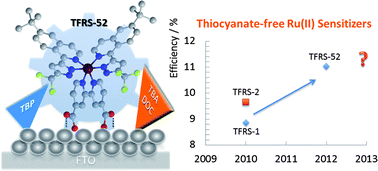In their recent EES article, scientists from Taiwan, Spain and Switzerland illustrate a practical strategy to achieve highly efficient dye-sensitized solar cells (DSSCs). They show that the short circuit current of a DSSC can be increased by the addition of fused aromatic substituents onto the polypyridyl Ru (II) sensitizers.
The extended pi-conjugation introduced by the aromatic substituents (isoquinolinyl groups) improves the optical absorptivity of this novel class of Ru(II) sensitizers, compared with the parent sensitizer TFRS-1. The DSSC incorporated with these dyes achieved over double-digit efficiencies.
Furthermore, the authors found that the addition of t-butyl substituents to the ancillary chelates results in longer device electron life-times. They were also able to optimize the cell by deprotonating the carboxy anchors during absorption.
Read this HOT EES article today:
Harnessing the open-circuit voltage via a new series of Ru(II) sensitizers bearing (iso-)quinolinyl pyrazolate ancillaries
Kuan-Lin Wu, Wan-Ping Ku, John N. Clifford, Emilio Palomares, Shu-Te Ho, Yun Chi, Shih-Hung Liu, Pi-Tai Chou, Mohammad K. Nazeeruddin and Michael Grätzel
DOI: 10.1039/C2EE23988D











